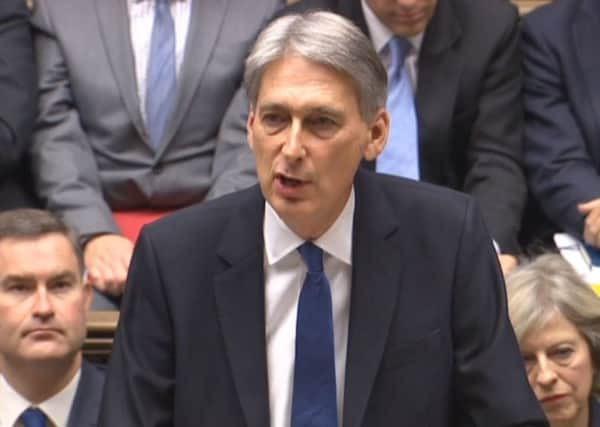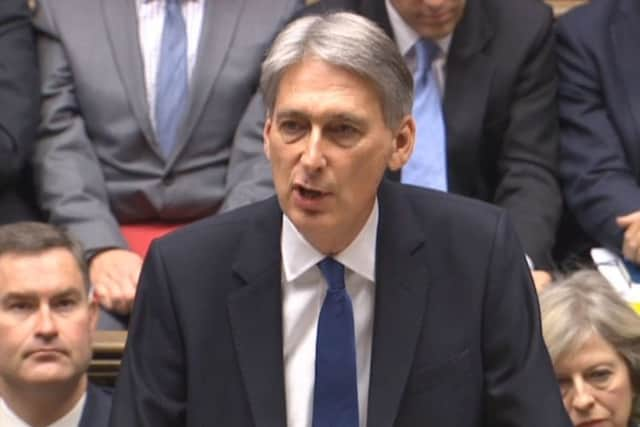Growth forecast slashed as Hammond delivers first and final autumn statement


Mr Hammond, who said his goal was to get the economy “match fit” for the “new chapter” ahead, unveiled a series of plans aimed at boosting productivity and helping low-income workers.
The Chancellor confirmed a freeze in fuel duty, a rise in the so-called National Living Wage and measures to ease cuts to Universal Credit.
Advertisement
Hide AdAdvertisement
Hide AdBut the Office for Budget Responsibility slashed growth forecasts for next year and predicted higher than previously expected borrowing, forcing Mr Hammond to confirm he was abandoning predecessor George Osborne’s plan to achieve a budget surplus.


Growth forecasts for next year were cut from the 2.2% predicted in March to just 1.4% as a result of the vote in June’s referendum, the Chancellor said.
His Autumn Statement included promises to Yorkshire of a share of £556m to help plans to grow the North economy, investment in transport ncluding developing the business case for renewing the Sheffield Supertram, and money to help Yorkshir host the 2019 Cycling Road World Championships.
Alongside the Autumn Statement, Mr Hammond also published a new “Northern Powerhouse Strategy” and the outcome of a review of education in the North led by Bradford headteacher Sir Nick Weller.
Advertisement
Hide AdAdvertisement
Hide AdMr Hammond said the slowdown was due to “lower investment and weaker consumer demand, driven, respectively, by greater uncertainty and by higher inflation resulting from sterling depreciation”.


But Shadow Chancellor John McDonnell said the Autumn Statement placed on record the “abject failure of the last six years”.
Mr Hammond also said he was consigning the Autumn Statement to the history books, with the main Budget moving from the spring to the autumn in future.
Setting out the OBR’s assessment, Mr Hammond said this year’s economic growth was expected to be 2.1%, higher than the previously forecast 2%.
Advertisement
Hide AdAdvertisement
Hide AdBut as the Brexit process unfolds, forecasts for both growth and the public finances have been downgraded.
Mr Hammond said: “While the OBR is clear that it cannot predict the deal the UK will strike with the EU, its current view is that the referendum decision means that potential growth over the forecast period is 2.4 percentage points lower than would otherwise have been the case.”
The national debt will breach the symbolically important 90% of GDP mark in 2017-18, the Chancellor told MPs.
Borrowing is set to be £68.2 billion this year and £59 billion next year, compared with previous estimates of £55.5 billion and £38.8 billion.
Advertisement
Hide AdAdvertisement
Hide AdIn 2018/19 the Government is set to borrow £46.5 billion, rather than the £21.4 billion forecast.
In his March Budget, Mr Osborne was able to tell MPs that he was forecast to deliver a £10.4 billion surplus in 2019/20 - but Mr Hammond said there was now expected to be £21.9 billion of borrowing.
The national debt is projected to rise from 84.2% of GDP last year to 87.3% this year, peaking at 90.2% in 2017-18 but falling thereafter.
Mr Hammond stressed that the OBR report confirmed the “underlying strength and resilience” of the British economy, but he acknowledged there was an “urgent need” to address long-term weaknesses.
Advertisement
Hide AdAdvertisement
Hide AdHe said: “This Autumn Statement responds to the challenge of building on that strength, while also heeding the warnings in the OBR’s figures, as we begin writing this new chapter in our country’s history.
“It restates our commitment to living within our means and it sets out our choice to invest in our future.
“It sends a clear message to the world that Britain is open for business and it provides help to those who need it now.”
The extra borrowing forecast by the OBR amounted to £122 billion.
Advertisement
Hide AdAdvertisement
Hide AdExplaining why he was abandoning Mr Osborne’s target, Mr Hammond told MPs: “In view of the uncertainty facing the economy, and in the face of slower growth forecasts, we no longer seek to deliver a surplus in 2019-20.
“But the Prime Minister and I remain firmly committed to seeing the public finances return to balance as soon as practicable, while leaving enough flexibility to support the economy in the near term.”
His new draft Charter for Budget Responsibility would commit the Government to returning the public finances to balance “as early as possible in the next parliament”.
In the interim, borrowing should be below 2% and public sector net debt should be falling as a share of GDP by the end of the parliament in 2020.
Advertisement
Hide AdAdvertisement
Hide AdWelfare spending would be kept within a cap set by the Government and monitored by the OBR, he added.
Theresa May has made it her ambition to help people who were “just about managing” - nicknamed “Jams” in Whitehall - and the Chancellor unveiled a series of policies aimed at helping low-paid workers.
They included:
• A rise in the minimum wage for over 25s, the so-called National Living Wage, from £7.20 to £7.50 in April 2017, worth over £500 to a full-time worker
• The continuation of the freeze in fuel duty, scrapping a planned rise in April, which will save the average car driver £130 a year
• Banning fees charged by letting agents to tenants
Advertisement
Hide AdAdvertisement
Hide Ad• A reduction in the Universal Credit (UC) taper rate from 65% to 63%, allowing people to keep more of the benefit as they work
But critics said the UC reform failed to compensate for the losses low-paid workers will face from previously-announced cuts.
As part of his measures aimed at boosting the economy and tackling the country’s productivity crisis, Mr Hammond set out a series of infrastructure pledges.
• A new National Productivity Investment Fund of £23 billion to be spent on innovation and infrastructure over the next five years
Advertisement
Hide AdAdvertisement
Hide Ad• Additional investment in research and development, rising to an extra £2 billion per year by 2020/21
• A £2.3 billion Housing Infrastructure Fund aimed at delivering up to 100,000 new homes in high-demand areas and £1.4 billion made available to deliver 40,000 additional affordable homes
• An additional £1.1 billion investment in English local transport, including pinch points on strategic roads, digital signalling on railways and low emission and autonomous vehicles
• Investment of more than £1 billion in digital infrastructure and 100% business rates relief on new fibre infrastructure
Advertisement
Hide AdAdvertisement
Hide AdThe Chancellor said: “We have chosen to borrow to kick-start a transformation in infrastructure and innovation investment.
“But we must sustain this effort over the long term if we are to make a lasting difference to the UK’s productivity performance.”
He said he had told the National Infrastructure Commission to make plans on the assumption that the Government would invest between 1% and 1.2% of GDP in economic infrastructure every year from 2020.
In order to help pay for the measures, Mr Hammond set out a range of tax hikes, including a crackdown on “unfair” salary sacrifice schemes which are used to reduce levies on employee benefits.
Advertisement
Hide AdAdvertisement
Hide AdFrom April 2017 Mr Hammond said he would align the employee and employer National Insurance thresholds at £157 per week, costing firms up to £7.18 a year for each worker.
He also announced a rise from 10% to 12% in insurance premium tax from next year.
Announcing a squeeze on salary sacrifice schemes, Mr Hammond said: “The Government will take action now to reduce the difference between the treatment of cash earnings and benefits.
“The majority of employees pay tax on a cash salary. But some are able to sacrifice salary and pay much lower tax on benefits in kind.
Advertisement
Hide AdAdvertisement
Hide Ad“This is unfair, and so from April 2017 employers and employees who use these schemes will pay the same taxes as everyone else.”
But he said ultra-low emission cars, pensions saving, childcare and the cycle-to-work scheme will be excluded from the change.
Mr Hammond also announced a further crackdown on tax dodges aimed at raising around £2 billion over the Autumn Statement forecast period.
Confirming that Whitehall spending squeezes will continue, Mr Hammond said plans set out in 2015 would remain in place.
Advertisement
Hide AdAdvertisement
Hide AdThe £3.5 billion of efficiency savings announced at the Budget are to be delivered in full, but departments which meet their targets would be able to reinvest £1 billion of efficiency savings in priority areas in 2019/20.